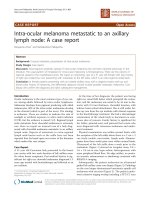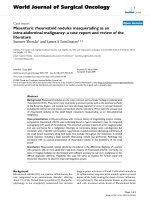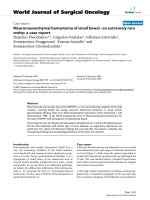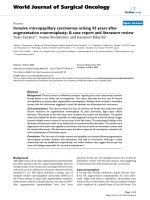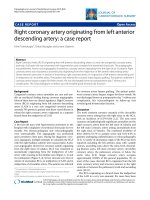Báo cáo khoa hoc:" Giant serous cystadenoma arising from an accessory ovary in a morbidly obese 11-year-old girl: a case report" pptx
Bạn đang xem bản rút gọn của tài liệu. Xem và tải ngay bản đầy đủ của tài liệu tại đây (940.21 KB, 4 trang )
BioMed Central
Page 1 of 4
(page number not for citation purposes)
Journal of Medical Case Reports
Open Access
Case report
Giant serous cystadenoma arising from an accessory ovary in a
morbidly obese 11-year-old girl: a case report
Steven M Sharatz*, Taína A Treviño, Luís Rodriguez and Jared H West
Address: Department of Obstetrics and Gynecology, Ponce School of Medicine, PO Box 7004, Ponce, PR 00732-7004, Puerto Rico
Email: Steven M Sharatz* - ; Taína A Treviño - ; Luís Rodriguez - ;
Jared H West -
* Corresponding author
Abstract
Introduction: Ectopic ovarian tissue is an unusual entity, especially if it is an isolated finding
thought to be of embryological origin.
Case presentation: An 11-year-old, morbidly obese female presented with left flank pain, nausea,
and irregular menses. Various diagnostic procedures suggested a large ovarian cyst, and surgical
resection was performed.
Conclusion: Histologically, the resected mass was not of tubal origin as suspected, but a serous
cystadenoma arising from ovarian tissue. The patient's two normal, eutopic ovaries were
completely uninvolved and unaffected. A tumor arising from ectopic ovarian tissue of embryological
origin seems the most likely explanation. We suggest refining the descriptive nomenclature so as
to more precisely characterize the various presentations of ovarian ectopia.
Introduction
Ectopic ovarian tissue is a rare phenomenon, with an inci-
dence estimated between 1 in 29,000 and 1 in 700,000
gynecologic admissions. A more accurate estimate is diffi-
cult due to a confusing and still disputed classification sys-
tem, as well as the frequently asymptomatic nature of the
condition. We report a case of what is best described as a
giant serous cystadenoma arising from an accessory ovary
in a morbidly obese 11-year-old girl.
Case presentation
An 11-year-old girl presented with two bouts of abdomi-
nal and left flank pain during a 5-month period, described
as non-radiating and 8 out of 10 in intensity. The pain was
accompanied by nausea and one episode of vomiting. The
patient also noticed a decrease in urinary frequency dur-
ing the same interval. She denied fever, dysuria, hematu-
ria, or bloody stools. Past medical and family history was
unremarkable. The patient had no history of hospitaliza-
tions, surgeries, or chronic illness. Menarche was at the
age of 10 followed by irregular cycles, occurring every 40
to 50 days with very heavy flow.
Physical examination revealed a morbidly obese (weight:
232 lbs., BMI: 42) adolescent girl. Her abdomen was soft
and depressible and no masses were identified on palpa-
tion. Various imaging studies were performed including a
pelvic ultrasound, which identified an 18.7 cm × 10.0 cm
× 15.4 cm cystic lesion that extended into the abdomen to
about the level of the umbilicus. Two MRI studies were
ordered which identified a large cystic structure that
appeared to originate from the right adnexa, suggesting an
ovarian tumor [Figures 1, 2]. Tumor markers were meas-
ured (CA-125: 30.2 U/ml, CA-19-9: 18 U/ml, AFP: 3 U/
Published: 18 January 2008
Journal of Medical Case Reports 2008, 2:7 doi:10.1186/1752-1947-2-7
Received: 5 June 2007
Accepted: 18 January 2008
This article is available from: />© 2008 Sharatz et al; licensee BioMed Central Ltd.
This is an Open Access article distributed under the terms of the Creative Commons Attribution License ( />),
which permits unrestricted use, distribution, and reproduction in any medium, provided the original work is properly cited.
Journal of Medical Case Reports 2008, 2:7 />Page 2 of 4
(page number not for citation purposes)
ml, LDH: 543 U/ml), and were all within normal limits. A
quantitative hCG and pregnancy test were negative. A pre-
sumptive diagnosis of ovarian cyst was made.
At laparotomy the cyst was found attached to the fimbri-
ated end of the left fallopian tube, with which it shared its
blood supply. On gross inspection, it was a smooth, mul-
tilobulated, fluid-filled mass with no attachments to the
left ovary itself. On close examination, the patient's two
ovaries showed no signs of torsion or necrosis: both were
smooth and atraumatic. Due to the size and location of
the cyst, a left salpingectomy was performed in order to
remove it completely. The patient was left with two intact
ovaries and her right fallopian tube. The presence of the
two normally situated ovaries was documented on follow-
up sonogram.
Due to the identification of two eutopic ovaries and the
attachment to the mass to the left fallopian tube, a post-
operative presumptive diagnosis of a left paratubal cyst
was made. On histological examination the specimen was
shown to be lined by columnar epithelial cells with abun-
dant cilia, and contain primary follicles, corpora albicans,
Graafian follicles, and areas of fibrin deposition [Figure
3]. The final histopathological diagnosis was hemorrhagic
serous cystadenoma arising from ovarian tissue. Patient
has recovered uneventfully from the procedure.
Discussion
We are aware of at least 50 published reports of additional
ovarian tissue since Wharton published his seminal
description in 1959 [1]. He defined an accessory ovary as
having close proximity and some form of association to a
eutopic ovary and its associated blood supply. The term
supernumerary ovary was reserved for ovarian tissue far
removed from the eutopic ovaries and with a separate
blood supply. The former is often found attached to the
fallopian tube or one of the various ligamentous struc-
tures of the ovarian-uterine complex; the latter can be
found anywhere along the embryological migratory path
of the ovarian primordium, including the mesentery, ret-
roperitoneal space, and omentum [2].
The terminology employed has caused substantial confu-
sion on the subject. The terms supernumerary and accessory
are somewhat misleading because their definitions by
Wharton presuppose two normal ovaries and an embryo-
Coronal T2-weighted MRIFigure 2
Coronal T2-weighted MRI.
Sagittal T1-weighted MRIFigure 1
Sagittal T1-weighted MRI. A large, fluid-density, multilobular
cystic structure is seen roughly at the midline and extending
to the level of the umbilicus. Although the cyst appears to
originate on the right, it was discovered at laparotomy to be
attached to the left fallopian tube.
Journal of Medical Case Reports 2008, 2:7 />Page 3 of 4
(page number not for citation purposes)
logic origin for the additional ovarian tissue. It has been
suggested that up to 50% of cases of additional ovaries are
actually post-inflammatory or post-surgical implants
[3,4]. Lachman et al have suggested doing away with the
traditional terms and labeling all abnormally placed ovar-
ian tissue as ectopic, subcategorized as either post-surgical,
post-inflammatory, or truly embryological [3]. Unfortu-
nately, this schema fails to make a distinction between 1)
extra tissue that is present in addition to two eutopic ova-
ries and 2) that which exists in place of a eutopic ovary
because it is the result of defective migration or develop-
ment of an ovarian primordium [5]. Therefore, it is diffi-
cult to precisely determine the incidence and categorize
the characteristics of the phenomenon.
About 36% of reported cases of ectopic ovary are associ-
ated with urogenital anomalies [6]. Their incidence in
patients with absent uterus is as high as 20%, and in as
many as 42% of cases of unicornuate uterus there is asso-
ciated ectopia, and often malformation, of the ovary con-
tralateral to the developed cornu [7]. The majority of cases
are classified as supernumerary by the Wharton criteria. The
detection of both supernumerary and accessory ovaries is
often associated with tumors or cysts, perhaps precisely
because these are symptomatic and require subsequent
workup. Some authors support the idea that this associa-
tion is due to increased pathological potential of the
ectopic tissue [6].
The most common masses identified are mature terato-
mas and mucinous cystadenomas, present in up to one
fifth of patients [5]. In addition, Brenner's tumor [8], scle-
rosing stromal tumor [9], serous cystadenoma [10],
serous cystadenofibroma [11], fibroma [12], and adeno-
carcinoma have been described. Common clinical presen-
tations involve abdominal pain and irregular menses.
Despite the strong association with pathological proc-
esses, supernumerary and accessory ovarian tissue has
been notoriously difficult to diagnose preoperatively. It is
usually an incidental finding or a surprise histopatholog-
ical diagnosis after resection of a clinically relevant mass,
as occurred in this case. It can be suspected on the basis of
hormonal abnormalities, such as continued cyclic
endometriosis pain [4] or intact estrogenic response to
human chorionic gonadotropin [13] after bilateral
oopherectomy. Fujiwara et al. have even made a presump-
tive diagnosis based on cyclic, FSH-associated changes in
a cystic mass, visualized by ultrasound [14]. Normally,
however, the nature of the mass is uncertain until histo-
logical confirmation is obtained.
The patient's young age and impressive weight are unu-
sual features of this case. To our knowledge, there have
only been five previously reported cases of additional ova-
ries diagnosed in children under the age of eighteen. This
includes the two neonatal diagnoses reported by Kuga et
al [2]. If the child's obesity is related somehow to a rapid
progression of the tumor that led to the relatively early
detection, the mechanism is uncertain: although various
hormone and gonadotropin receptors have been detected
to varying degrees on samples from the spectrum of serous
ovarian neoplasms, they have not been shown definitively
to promote tumor growth [15,16]. Unfortunately, we do
not have comprehensive hormone levels for our patient,
although one would expect her estrogen levels to be
increased (due to obesity) and her FSH levels to be chron-
ically decreased (due to pituitary axis inhibition); her ova-
ries were not polycystic and she was not hirsute,
suggesting normal LH and androgen levels.
To improve the precision of the terminology, we would
propose that the term ectopic continue to refer to any inap-
propriately placed ovarian tissue, regardless of etiology or
the presence of two eutopic ovaries. The description can
be fine-tuned according to the salient features of the spe-
cific presentation and its suspected etiology, e.g. "extra/
additional" if accompanied by normal ovaries, or "mal-
formed" if the product of faulty migration or malforma-
tion of a would-be eutopic gonad. One can invoke the
term "implant" when that etiology is suspected, and Lach-
man's proposed adjectives "post-surgical" and "post-
inflammatory" applied. All permutations of etiology and
location can thus be accurately and completely described
(e.g., "ectopic extra ovary," "post-inflammatory ectopic
implant," or "unilateral ectopic ovarian malformation/
remnant"), not previously possible. The terms supernumer-
ary and accessory should retain their traditional Wharto-
Histology of the resected mass shows a Graafian follicle and an inner lining of ciliated columnar epithelium, consistent with a benign cystadenoma derived from ovarian tissueFigure 3
Histology of the resected mass shows a Graafian follicle and
an inner lining of ciliated columnar epithelium, consistent
with a benign cystadenoma derived from ovarian tissue.
Publish with BioMed Central and every
scientist can read your work free of charge
"BioMed Central will be the most significant development for
disseminating the results of biomedical research in our lifetime."
Sir Paul Nurse, Cancer Research UK
Your research papers will be:
available free of charge to the entire biomedical community
peer reviewed and published immediately upon acceptance
cited in PubMed and archived on PubMed Central
yours — you keep the copyright
Submit your manuscript here:
/>BioMedcentral
Journal of Medical Case Reports 2008, 2:7 />Page 4 of 4
(page number not for citation purposes)
nian definitions in that they refer to distinct presentations
of additional (extra) ovarian tissue.
Conclusion
Our case represents an accessory ovary according to the
Wharton criteria, given its adnexal location and a blood
supply continuous with that of the fallopian tube. We
believe that the tissue is truly embryologically ectopic, to
reference Lachman's nomenclature, because of the
absence of previous pelvic or abdominal surgery or dis-
ease; also significant is the smooth, atraumatic appear-
ance of the eutopic ovaries at laparotomy. To our
knowledge, this is the second report of a serous cystade-
noma arising from an accessory or supernumerary ovary,
and it is among the largest masses reported arising from
either.
Competing interests
The author(s) declare that they have no competing inter-
ests.
Authors' contributions
All authors have read and approved the final manuscript
for publication.
1) SS performed manuscript writing, literature review, and
collection and analysis of pertinent clinical information.
2) TT participated in the clinical management of the
patient, the surgery in which the sample was removed,
collection and analysis of pertinent clinical information,
and literature review.
3) LR was the attending physician on the case, and there-
fore performed the surgery and managed the clinical care
of the patient; he also gave the authorization for final pub-
lication.
4) JW participated in literature review, and collection and
analysis of pertinent clinical information.
Consent
Written consent was obtained from the patient's legal
guardian (mother) for the publication of this case report
and any accompanying images. A copy of this written con-
sent is available for review by the Editor-in-Chief of this
journal.
Acknowledgements
The authors received no funding for the creation of this case report.
We acknowledge and thank Dr. Axel Arroyo, pathologist, for his assistance
with this case.
References
1. Wharton LR: Two cases of supernumerary ovary and one of
accessory ovary, with analysis of previously reported cases.
Am J Obstet Gynecol 1959, 78:1101-1119.
2. Kuga T, Esato K, Takeda K, Sase M, Hoshii Y: A supernumerary
ovary of the omentum with cystic change: report of two
cases and review of the literature. Pathol Int 1999, 49(6):566-70.
3. Lachman M, Berman M: The ectopic ovary: a case report and
review of the literature. Arch Pathol Lab Med 1991, 115:233-235.
4. Litos MG, Furara S, Chin K: Supernumerary ovary: a case report
and literature review. J Obstet Gynaecol 2003, 23(3):325-7.
5. Watkins BP, Kothari SN: True ectopic ovary: a case and review.
Arch Gynecol Obstet 2004, 269(2):145-6.
6. Vendeland LL, Shehadeh L: Incidental finding of an accessory
ovary in a 16-year-old at laparoscopy: a case report. J Reprod
Med 2000, 45(5):435-8.
7. Dabirashrafi H, Mohammad K, Moghadami-Tabrizi N: Ovarian mal-
position in women with uterine anomalies. Obstet Gynecol
1994, 83:293-4.
8. Heller DS, Harpaz N, Breakstone B: Neoplasms arising in ectopic
ovaries: a case of Brenner tumor in an accessory ovary. Int J
Gynecol Pathol 1990, 9:185-9.
9. Andrade LALA, Gentilli ALC, Grimalde P: Case report: sclerosing
stromal tumor in an accessory ovary. Gynecol Oncol 2001,
81:318-9.
10. Mercer LJ, Toub DB, Cibilis LA: Tumors originating in supernu-
merary ovaries: a report of two cases. J Reprod Med 1987,
32(12):932-4.
11. Whitaker C, Tawfik O, Weed JC Jr: Serous cystadenoma arising
in an ectopic ovary. Kans Med 1997, 98(2):24-6.
12. Kamiyama K, Moromizato H, Toma T, Kinjo T, Iwamasa T: Two
cases of supernumerary ovary: one with large fibroma with
Meig's syndrome and the other with endometriosis and
cystic change. Pathol Res Pract 2001, 197(12):847-51.
13. Kosasa TS, Griffiths CT, Shane JM, Leventhal JM, Naftolin F: Diagno-
sis of a supernumerary ovary with human chorionic gonado-
tropin. Obstet Gynecol 1976, 47:236-7.
14. Fujiwara K, Shirotani T, Kohno I: Supernumerary ovary found by
ultrasonogram and FSH measurement after an extensive
operation for a yolk sac tumor of the ovary. Gynecol Obstet
Invest 1999, 48(2):138-40.
15. Basille C, Olivennes F, Le Calvez J, Beron-Gaillard N, Meduri G,
Lhommé C, Duvillard P, Benard J, Morice P: Impact of gonadotro-
pins and steroid hormones on tumor cells derived from bor-
derline ovarian tumors. Hum Reprod 2006, 21(12):3241-5.
16. Wang J, Lin L, Parkash V, Schwartz PE, Lauchlan SC, Zheng W: Quan-
titative analysis of follicle-stimulating hormone receptor in
ovarian epithelial tumors: A novel approach to explain the
field effect of ovarian cancer development in secondary mul-
lerian systems. Int J Cancer 2003, 103(3):328-34.


